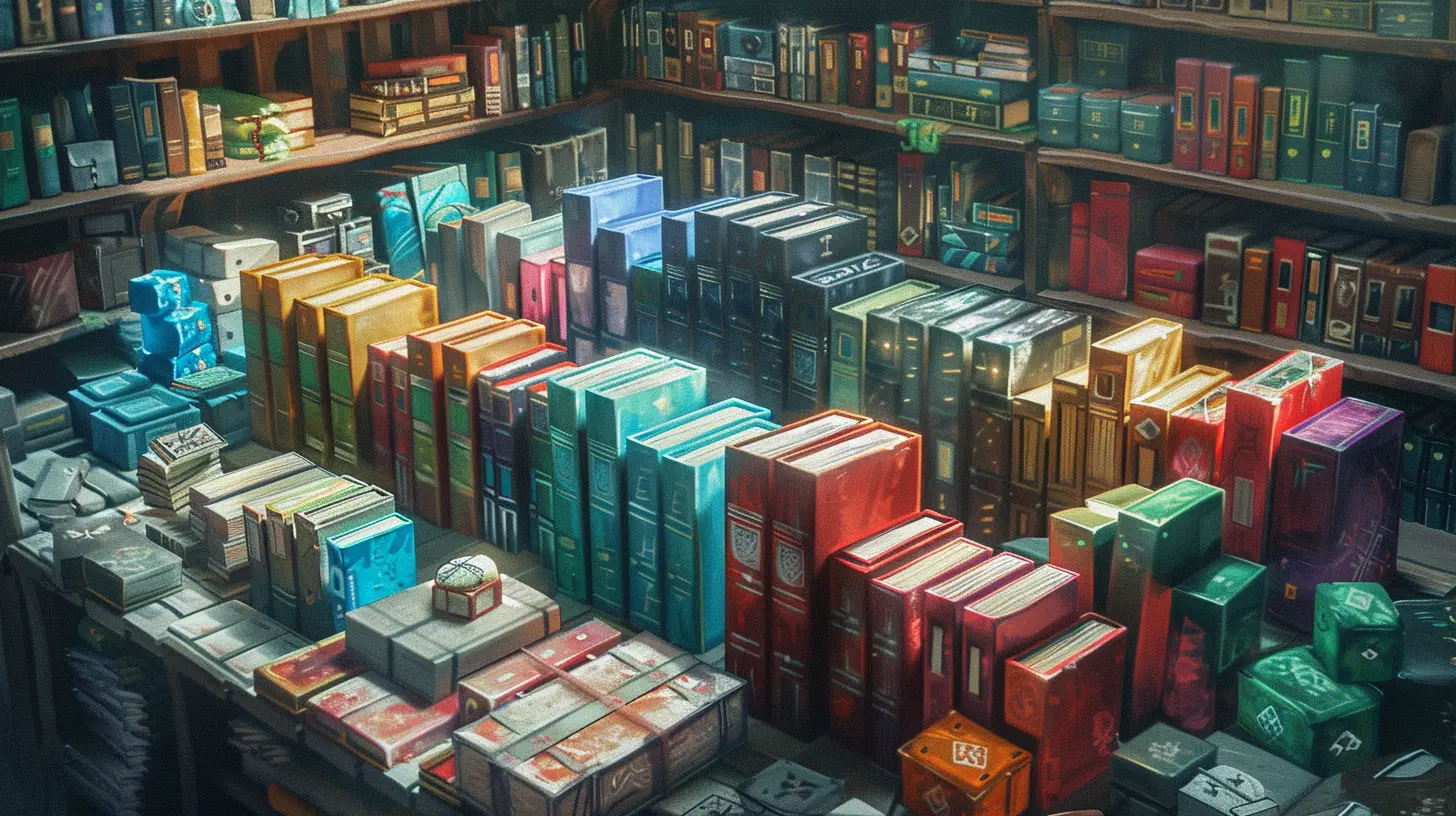Best Practices for Inventory Management Across Genres
28 October 2025
Let’s be real—inventory management in games can either be a smooth, satisfying experience or an absolute nightmare. Whether you're hoarding potions in an RPG, juggling loot in a survival sim, or desperately trying to find space for another shotgun in a horror game, inventory systems can make or break the fun.
No one wants to spend half their playtime rearranging digital backpacks. But hey, different genres call for different approaches, and what works in a rogue-like might fall apart in a looter-shooter. So, let’s dive into the best practices for inventory management across different game genres—and how developers and players alike can get the most out of their item-handling systems.
Why Inventory Management Matters More Than You Think
Before we break it down genre by genre, let’s talk about why inventory design is such a big deal. It’s not just about space—it’s about pacing, immersion, and even strategy. A good inventory system keeps players in the game, not in the menus. It should feel like a tool, not a chore.Think of it like your real-life backpack. If it’s organized and easy to access, you’re good to go. But if you're digging through a mess every time you need something, you're gonna get frustrated—fast.
RPGs: Complex Systems, Thoughtful Limits
Role-playing games (RPGs) are notorious for massive inventories. From healing items to quest objects, unique weapons, and crafting materials, there’s a lot to juggle.✅ Best Practices for RPG Inventory Systems:
1. Give Players Room to Grow
Start simple, but allow for upgrades. Players love progression, and adding inventory capacity as part of leveling or quests makes it feel earned. Think "The Legend of Zelda" with those ever-expanding bags.2. Categorize, Don't Overwhelm
Divide inventory into tabs or categories: weapons, armor, potions, etc. The last thing anyone wants is to scroll through 200 items to find one healing herb. Bonus points if you let us sort by rarity or damage.3. Auto-Sorting & Clean Interface
Let’s normalize the "Auto-Sort" button, folks. Also, keep the UI sleek and readable. Beautifully designed icons help too—visual recognition is way faster than reading tiny item names.4. Limit With Purpose
Weight limits or item stacks? Sure—but only if they add challenge or realism. Skyrim’s carry weight mechanic adds immersion, but too many limits can feel like artificial roadblocks.
Shooters: Keep It Fast and Functional
In first-person or third-person shooters, inventory should be less about quantity and more about making quick choices. No one wants to fumble through gear while under fire.✅ Best Practices for Shooter Inventories:
1. Minimalism Wins
Two weapons max? Perfect. Think Halo or Call of Duty—simple loadouts force players to make meaningful choices and avoid decision paralysis.2. Quick-Swap and Hotkeys
If I have to go into a menu mid-battle, something's gone wrong. Players should be able to cycle through items effortlessly. Hotkeys, quick wheels, and intuitive shortcuts are a must.3. Ammo and Gear Indicators
Ammo counts, grenade types, health kits—these should always be visible. Keep the focus on the action, not the inventory screen.4. Real-Time vs. Paused Inventory
Some games pause during inventory usage (like The Division), while others don’t. Choose based on game style. For tight, fast-paced combat, real-time adds tension. For tactical play, pause it up.
Survival Games: The Art of Smart Hoarding
Ah yes, the genre where hoarding is king—but every item might matter. From Rust to The Forest, survival games are inventory Tetris at its finest.✅ Best Practices for Survival Inventories:
1. Grid-Based Systems = Strategy
Games like DayZ or Resident Evil use grid-based storage, where item size matters. That’s not just realistic—it’s also a fun puzzle. Don’t ditch it, but make sure it’s manageable.2. Crafting Integration
Inventory and crafting go hand-in-hand in survival titles. Make crafting items directly from inventory a seamless experience. Players shouldn’t have to memorize recipe books every time.3. Encumbrance That Feels Fair
Weight systems and stamina penalties? Cool. But they should scale with gear improvements. Let players build better backpacks or wear stronger belts to lighten the load over time.4. Temporary Stashes & Base Management
Let players build storage at base camps or hide stashes in the world. This encourages exploration and planning, which is exactly what the genre thrives on.Horror Games: Limitations for the Sake of Fear
Inventory tension isn't always bad—especially in horror. In fact, it’s often the point. Ever had to choose between an herb or shotgun shells in Resident Evil? That’s survival horror gold.✅ Best Practices for Horror Inventories:
1. Make It Tight, But Not Torturous
Limited space adds stakes. Make every item choice matter. But don’t go so far that it feels frustrating. Offer storage chests or item boxes to balance things out.2. Real-Time Inventory = Real Terror
Opening your bag while a monster creeps up behind you? That’s next-level stress. If your aim is panic, don’t pause. If you want more strategy, let players think it through safely.3. Visual Inventory = More Immersion
Resident Evil’s suitcase-style grid makes you feel like you're really packing for the apocalypse. Let visuals sell the experience, not just numbers in lists.4. Combine & Examine Features
Combining items (like mixing herbs or loading ammo) and examining them for clues or hidden mechanics adds depth—and it’s a classic survival horror flavor.MMOs: Mass Items, Massive Problems
MMORPGs are beasts when it comes to inventory sprawl. Gear sets, potions, crafting mats, collectibles—there’s just so much stuff.✅ Best Practices for MMO Inventory Systems:
1. Bank System & Shared Storage
Give players a home base with deep storage options. Shared inventories between characters on the same account? Even better.2. Smart Filters and Search Bars
A search function should be mandatory. Labeled filters, colors for rarities, and sortable stats make life 100x easier.3. Auto-Stacking & Cleanup Tools
Auto-stacking similar items and offering “clean up bag” buttons can save hours. MMOs already take up enough time—let the inventory work with us, not against us.4. Expandable Space via Progress or Store
Want to sell inventory upgrades? Fine. Just make sure it’s optional and not a paywall to enjoyment. A balance of earned and purchased space is key.Indie & Puzzle Games: Keep It Minimal or Innovative
Indie games often play fast and loose with genre rules, and inventory design is no exception. You’ll find everything from minimalist UIs to completely original item management systems.✅ Best Practices for Indie Game Inventory:
1. Match It to the Vibe
If you’re building a narrative-heavy game, keep inventory super simple—maybe even invisible. If your game revolves around object manipulation, get creative! Use drag-and-drop, rotatable objects, or even physical inventory puzzles.2. Inventory as a Mechanic
Some indies turn their inventory into a game itself. Think Backpack Hero, where your layout affects your abilities. When done right, this elevates inventory from UI to gameplay.3. Let the Player Discover
Unusual inventory systems work best when they encourage exploration. Tooltips, tutorials, or NPC hints go a long way without being hand-holdy.Cross-Genre Takeaways: What Every Game Can Learn
No matter the genre, some inventory principles are universal. These are the golden rules that every dev (and even players thinking of modding) should keep in mind:🔁 Intuitive UX/UI
Don’t overcomplicate. If players can’t figure it out in 30 seconds, it’s too complex. Tooltips, icons, and drag-and-drop go a long way.🛠️ Customization is King
Let players sort it how they want. Grid view, list view, auto-sort, manual arrangement—provide options.📈 Scalability
The further you go in the game, the bigger your inventory should be able to grow. That doesn’t mean unlimited—it means smart growth.🎯 Context-Sensitive Design
Design with the genre in mind. What's helpful in an RPG might be a nightmare in a shooter. Adapt your system to your game’s tempo and purpose.Final Thoughts: Inventories Should Feel Like an Extension of the Player
At the end of the day, managing your gear, loot, and tools should feel second nature—not like doing taxes. Whether you’re slicing dragons, dodging headshots, or crafting a cozy cabin, your inventory should support your journey, not stunt it.So next time you find yourself sorting gear and wondering, “Why does this feel so tedious?”, remember—it’s not you, it’s the design. And if you're a dev, take this as your sign to revamp that cluttered UI. Give us inventories we want to spend time with, not escape from.
Stay organized, stay looted, and for the love of gaming—give us an auto-sort button already.
all images in this post were generated using AI tools
Category:
Game GuidesAuthor:

Leandro Banks
Discussion
rate this article
1 comments
Virginia Banks
Great read! Inventory management can feel like a puzzle, but with these best practices, you’ll turn chaos into clarity. Keep experimenting, have fun, and soon you'll be a master at managing your in-game treasures! 🕹️✨
October 29, 2025 at 4:04 AM

Leandro Banks
Thank you! I'm glad you enjoyed it. Happy gaming and inventory managing! 🕹️✨


